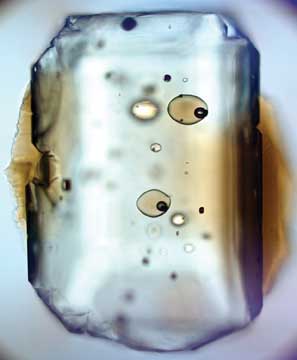|
NEWS NOTES — NEWS
Volcanoes
Are volcanoes picky eaters?
 Image is courtesy of Alexander Sobolev |
| Minerals trapped inside olivine reveal clues about the source of volcano-building magmas. |
The phrase “you are what you eat” evidently also applies to volcanoes. New measurements of the concentrations of elements within magma suggest a volcano’s food may be a complex recipe — and that what kind of magma a volcano prefers may affect its physical features, including the size to which it can grow, according to new research published April 20 in Science.
Magma forms deep belowground, where the temperature and pressure are high enough to melt rock. But what rocks make up the magma — how much of the melted rock comes from deep within the mantle and how much is crust that re-enters the mantle during subduction — has remained a long-standing question among geologists.
One way to distinguish between mantle and crust sources is by the type of rock. In the mantle, the primary rock is peridotite, made up of a mineral called olivine. When peridotite mixes with subducted ocean crust, however, it forms a new kind of rock called hybrid pyroxenite, which is chemically distinct from peridotite. Knowing how much peridotite and pyroxenite go into any volcano’s diet can change significantly how the volcano behaves, says Alexander Sobolev, a geochemist at the Vernadsky Institute of Geochemistry at the Russian Academy of Sciences in Moscow.
Geologists have devised ways to try to tell the two rock sources apart, including analyzing melts for rare trace elements found primarily in the crust, or for telltale isotopic ratios that act as fingerprints for the crust or mantle. But those approaches are tricky because the complicated processes of melting and subduction can erase or blur those fingerprints, according to Claude Herzberg of Rutgers University in Piscataway, N.J., who wrote an accompanying perspective story in the same issue of Science.
Sobolev and colleagues decided to try a more old-fashioned approach. The rocks that make up pyroxenite melts contain more nickel and silicon but less calcium, manganese and magnesium than the rocks that form peridotite melts. Therefore, the team chose to analyze the concentrations of such major elements, including nickel, manganese, calcium and cobalt, in large crystals trapped within olivine grains from hundreds of volcanoes around the world. Using equipment at the electron microprobe facility at the Max Planck Institute for Chemistry in Mainz, Germany, the team could analyze the samples with precision that was almost 10 times better than previous methods, Sobolev says.
The team found that the crystals did record the chemical differences between the two melts, and that analyses of more than one major element can also help to fully resolve the differences. Although the chemical distinctions between many of the main types of volcanic rock, such as basalts from mid-ocean ridges versus those on ocean islands, are well known to geologists, the team also found that not all ocean island volcanoes prefer the same diet. While Hawaiian Island volcanoes, for example, consume large amounts of recycled crust, the data suggest that other ocean island volcanoes, such as the Cook Islands off of New Zealand in the South Pacific, prefer the mantle magma.
Those preferences matter because they can explain why some volcanoes or magmatic regions can grow quite large. At similar temperatures, the hybrid pyroxenite mixture will produce “much more melt” than mantle peridotite alone, Sobolev says. Without their mixed diet, for example, Hawaiian volcanoes would have amounted to only “small sea mounts beneath the ocean surface,” he says. This difference in taste could also explain the magmatic flood of the Siberian Traps, a region where about 250 million years ago, volcanism spread basalt lava across an area equal to half the size of Australia — an event that some think contributed to climate change and a mass extinction (see Geotimes, August 2002).
The team used “great precision and huge amount of data” to come up with their findings, says Marc Hirschmann, a geologist at the University of Minnesota at Minneapolis. The study, however, is “definitely not the final word,” Hirschmann says. Other researchers, for example, have said the geochemistry of Hawaii’s magma suggests it originates deep in Earth’s mantle, near the core-mantle boundary. Still, Hirschmann says, the research is “a step forward” in understanding the compositions of Earth’s magmas, and it will likely stimulate future research to take new directions.
Links:
"Suspect killer: volcanism," Geotimes, August 2002

 Subscribe
Subscribe


